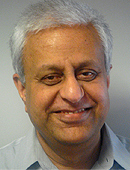
Srinivas (ravi) Iyengar, PhD
About Me
Dr. Iyengar is a Dorothy H. and Lewis Rosenstiel Professor in the Department of Pharmacology and Systems Therapeutics.
Trained as a biochemist, Dr. Iyengar's research focuses on cell signaling networks with emphasis on heterotrimeric G protein pathways. His laboratory uses a combination of experimental and computational approaches to understand the regulatory and information processing capabilities of cellular signaling networks, and how they affect cell and tissue physiology.
Research Interests:
Systems pharmacology and systems biology
Computational cell biology
Cellular signaling networks
Spatial modeling of cell signaling
G-protein mediated intracellular signaling in neurons
Spatiotemporal organization of cellular networks, and physiological outcomes
Websites:
In the News:
GLP-1, TZD Combo May Cut Heart Risk
Big Data Reaps Big Rewards in Drug Safety
Can 'Big Data' Help Increase Drug Safety?
Mount Sinai School of Medicine Bringing Free Courses Online
Mount Sinai Discovers Genetic Framework to Explain and Predict Adverse Drug Reactions
Language
English
Position
DIRECTOR, MOUNT SINAI INSTITUTE FOR SYSTEMS BIOMEDICINE, PROFESSOR | Pharmacological Sciences
Research Topics
Axonal Growth and Degeneration, Bioinformatics, Cardiovascular, Cell Biology, Cell Motility, Cell Transformation, Computational Biology, Computer Simulation, Cytoskeleton, Hippocampus, Kidney, Mathematical and Computational Biology, Membranes, Memory, Phosphorylation, Protein Kinases, Proteomics, Receptors, Signal Transduction, Synaptic Plasticity, Systems Biology, Theoretical Biology, Transcription Factors, cAMP
Multi-Disciplinary Training Areas
Disease Mechanisms and Therapeutics (DMT), Neuroscience [NEU]
Education
BS, Bombay University
MSc, Bombay University
MS, University of Houston
PhD, University of Houston
Fellowship, Baylor College of Medicine
Research
The Iyengar laboratory is focused on understanding how signals are routed and processed through cellular signaling networks including mechanisms of information sorting and integration in the context of cell and tissue level functions.
We are interested in understanding dynamics of network topology. For this we focus on identifying regulatory motifs such as feedback and feedforward loops and determining their information processing capability. We have constructed and analyzed dynamic maps of these motifs to understand how cellular signaling networks engage the various cellular machinery to produce physiological responses to extra-cellular signals. To study complex cell signaling networks we utilize a combination of experimental and theoretical approaches. Multidimensional experimental approaches currently being used in the laboratory proteomics, bulk transcriptomics and single cell RNA-seq and mRNA profiling by sequencing. These experimental approaches are being integrated with theoretical analysis using both graph theory approaches differential equation based modeling to understand network regulation of cell proliferation and activity induced synaptic plasticity and physiological function.
We are interested in understanding how spatial organization within cells and tissues contributes to dynamic stability. We are studying the role of cell shape in regulating information processing within signaling networks. For these studies at the experimental level we are using approaches to observe and quantify biochemical signaling reactions in live cells. We are also using patterned surfaces at the nano and microscale as to obtain cells of specific shapes that can be imaged. To decipher the information content in cell shape we are analyzing signaling networks using partial differential equations. We are developing spatially realistic models of signaling networks to understand the origins and dynamics of microdomains of signaling components. We are also interested in understanding the dynamics underlying tissue integrity. We are using spatial transcriptomic data to develop multi-scale models as well to determine if dynamic loops that integrates signaling networks in multiple cell types forms the basis for tissue integrity and physiological function.
We are developing systems level approaches to understanding drug action at a genome-wide level. We are constructing large scale networks to capture all of the known protein-protein interactions in the human genome to computationally identify selective regions (disease neighborhood) within the interaction space associated with specific diseases. We are analyzing the relationship between drug targets and other cellular components to understand the relationship between disease neighborhood and targets of drugs used to treat the disease. From such analyses we are attempting to predict adverse events and explain adverse events reports in the FDA–AERS database.
For more information, please visit the Iyengar Laboratory, Systems Pharmacology and Systems Biology website.
Publications
Selected Publications
- Multiscale mapping of transcriptomic signatures for cardiotoxic drugs. Jens Hansen, Yuguang Xiong, Mustafa M. Siddiq, Priyanka Dhanan, Bin Hu, Bhavana Shewale, Arjun S. Yadaw, Gomathi Jayaraman, Rosa E. Tolentino, Yibang Chen, Pedro Martinez, Kristin G. Beaumont, Robert Sebra, Dusica Vidovic, Stephan C. Schürer, Joseph Goldfarb, James M. Gallo, Marc R. Birtwistle, Eric A. Sobie, Evren U. Azeloglu, Seth I. Berger, Angel Chan, Christoph Schaniel, Nicole C. Dubois, Ravi Iyengar. Nature Communications
- Integrating Metabolomics and Transcriptomics to Characterize Differential Functional Capabilities of Kidney Proximal Tubule Cell Subtypes. Jens Hansen, Mustafa M. Siddiq, John Cijiang He, Ravi Iyengar. Seminars in Nephrology
- Overview: Spatial Metabolomics Review Series. Kumar Sharma, Ravi Iyengar. Seminars in Nephrology